
views
Targeting Essential Muscles
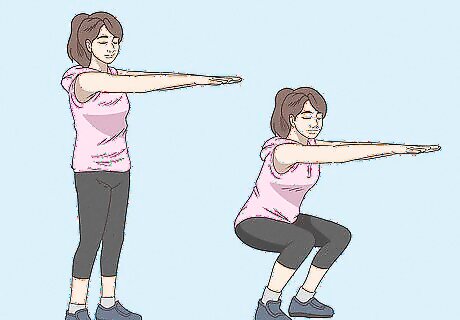
Build your leg muscles. Your legs are the powerhouse of your jump. The stronger your leg muscles are, the harder you can propel yourself upwards to a maximum vertical leap. The type of exercises you can do will depend on the equipment you have available to you. Consult a health or fitness specialist to ensure your body is able to strengthen itself in a healthy manner. Focus on exercises that mimic the jumping motion. A good way to do this is by doing squats, which can be done with or without equipment. Squats can be done by simply standing with your legs shoulder width apart and lowering your body towards the ground with your back straight and knees bent at a 45-degree angle as if you were sitting down on a chair. Stand up straight and repeat. Increase the intensity by adding weights, being careful to incrementally increase weights as your strength increases. Lunges strengthen your glutes and can be done with or without equipment. Lunges can be done by simply standing up straight and taking one step forward with your back straight and knee bent at a 45-degree angle. Step out farther for a more difficult lunge. Stand up straight and repeat, making sure to alternate legs. Increase the intensity by adding weights, being careful to incrementally increase weights as your strength increases. Before using any equipment, consult a specialist to ensure its proper use.
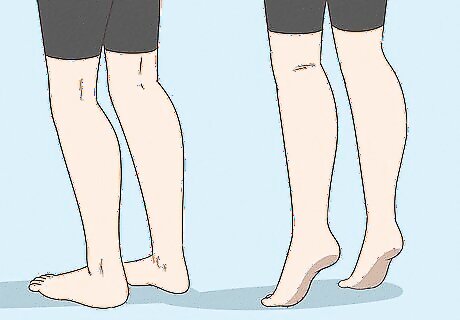
Strengthen your calves. This muscle group is essential to jumping higher. Calf raises are an easy and effective exercise that can be done with or without equipment. Calf raises can be done by standing up straight with your feet on the ground and then moving up onto your tippy toes. Stand at a ledge to increase the range of motion to your muscles. You can also do one leg at a time making sure to alternate between each leg to ensure balance. Increase the intensity by adding weights, being careful to incrementally increase weights as your strength increases.
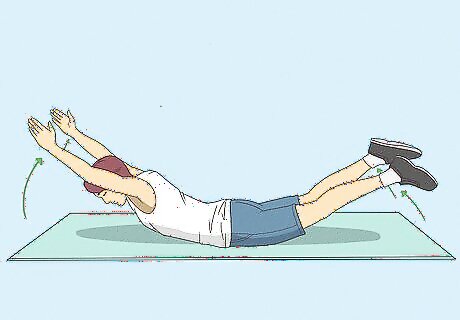
Build your core muscles. Contrary to popular belief, jumping isn't just about the muscles in your legs. Your core muscles in your back and abdominals are a big part of your body movement and are engaged for balance and coordination. Many core workouts can be done without equipment. Some good workouts to build these muscles are crunches and supermans. There are many variations of abdominal exercises, one of the simplest is the crunch. Lay down with your back and feet on the ground with your knees bent. Keeping your feet and glutes on the ground, crunch your abdominal muscles as you move your upper body toward your knees. You can keep your hands behind you or out in front of you. Lower yourself back down to the starting position and repeat. Be careful to move with purpose, isolating your abdominal muscles and being careful to avoid any jerking movements that could be harmful to your lower back. Supermans are a great compliment to crunches as they strengthen your lower back. Lay face down with your hands above your head to mimic a flying “Superman”. Raise both your upper body and legs simultaneously and hold for a beat to isolate the muscles of your lower back. Lower back down to the starting position and repeat as necessary.
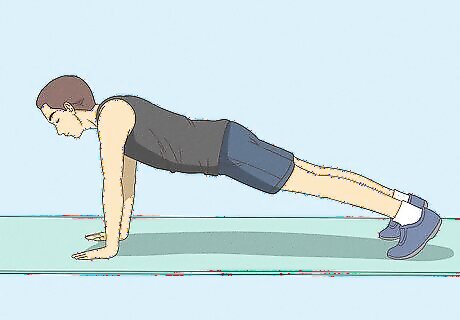
Build your arm muscles. Arm muscles are also a big part of jumping higher as they provide momentum as you explode upwards. Arms are also a big part of your approach (when you go up to hit a ball or block). Many good workouts for your arms can be done with weights or equipment. Push ups and pull ups can be done with minimal equipment while bicep curls and tricep pushdowns need weights or equipment for resistance. Push-ups can be done without any equipment by laying down face down with the palms of your hands on the ground and your arms extended, perpendicular to your body, but bent at the elbows. Push down onto the palm of your hands, lifting your body off the ground and straightening your arms. Lower yourself back down to the starting position and repeat. Change the positioning of your hands to target different muscles. Pullups need to be done with a bar high enough to lift yourself off of the ground. Simply grab the bar above your head and lift yourself towards the bar. It may be difficult at first but try to keep your body straight and allow yourself to rise and fall in the full range of motion of your arms. You can either keep your palms facing away from you or towards you, varying the distance between them. Changing the positioning of your hands will target different muscles. Try not to let your arms fall straight down and lock. It is better to keep some bend in them between pullups. Bicep curls can be done with weights or equipment by simply keeping your arm straight at your side and lifting the weight toward your bicep, bending at the elbow. Alternate between arms. Changing your grip targets different areas of your bicep and forearm muscles. Bench dips work your triceps, can be done almost anywhere, and requires no equipment. Put your arms behind you on the edge of a tub or on a chair so your fingers are pointing out. Keep your elbows slightly bent and close to your body. Extend your legs and bend them slightly at the knee. Lower your body until your elbows are at a 90-degree angle and lift yourself back up. Tricep pushdowns are done with specialized equipment, usually with cables used to move weights. Usually ropes, bars, or handles are attached to the end of the cable. Utilizing different attachments focuses on different areas of your triceps. Stand straight with your feet shoulder width apart and pull the cable down by the attachment starting with your elbows at 90 degrees and extending downward, moving your hands towards the ground. Consult a fitness specialist for the proper use of each attachment.
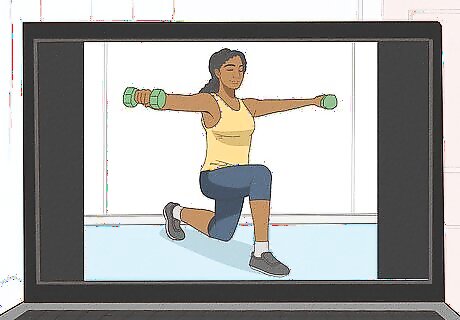
Find workouts that help and motivate you. Lifting weights and exercising as a whole can be repetitive and boring. Find exercises that help workout your muscles or get you jumping without losing motivation. There are many free resources online to help you vary your workout and find exercises that work for you.

Find inspiration through partners, trainers, and music. Jam out to some of your favorite tunes to keep your mind distracted from the repetition. High energy music can also keep your energy up. Find a trainer, training partner or a workout video for support. Trainers can be expensive but worth the investment to ensure your safety and maximize your potential. Choose your training partners wisely as you want to support each other. It’s easy to create a social atmosphere and get distracted from the task at hand when you workout with friends who don’t have the same goals as you.
Utilizing Plyometrics
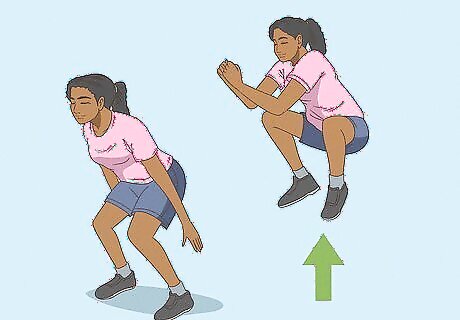
Research and develop a plyometric routine that works best for your schedule and space. Plyometrics are great because they require minimal equipment and require various explosive movements; however, they can be a challenge to commit to if you only have limited amount of space and time available to you. Choose exercises that will challenge you in the time you have scheduled for yourself. Here is an example of a plyometric routine specifically made to jump higher for volleyball. Do each exercise for 15 repetitions, completing the entire routine 2-3 times through. 15 Minutes of Cardio to warm up. 15 Knee Tuck Jumps: jumping straight up as you raise your knees and tuck them toward your chest. 15 Lateral Jumps: jumping side to side keeping your feet together. 15 Mountain Climbers: starting at a plank position (the top part of a pushup), quickly move your feet towards your hands, as if you were running in place with your hands securely pushed against the ground. 15 Broad Jumps: jumping forward as far as you can, from a stationary standing position, focusing on distance rather than eight. 15 Burpees: starting from a plank position, quickly move to your feet and explode into a jump (it’s a combination of a pushup and vertical jump). 15 Squat Jacks: squatting down with your feet shoulder width apart and legs bent just above a 90 degree angle, move your feet in and out, quickly moving your inner thighs towards each other. 15 Agility Dots: trace an imaginary square on the ground and jump sideways and diagonally towards each corner of the square, keeping your feet together, to create an X pattern. 15 Squat Jumps: get into a squat position and explode into a jump. Cool Down and Stretch.

Integrate plyometrics into a weight lifting program. To keep yourself from getting bored and your muscles and gains from hitting a plateau, you can add plyometric workouts 2-3 times a week in conjunction with cardio and bodyweight exercises in order to jump higher. To make the plyometrics even more effective, wear a weighted vest while you do the exercises. These plyometrics exercises should only be done on even ground to avoid sprains and injuries. Never do the exercises on concrete as the impact can be rough on joints.
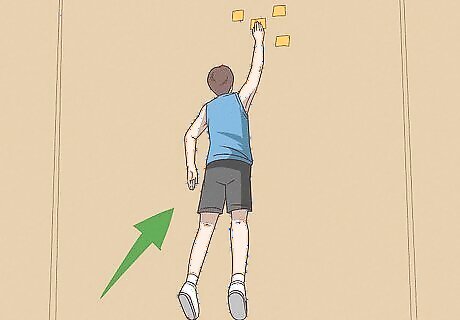
Practice jumping. Practice makes perfect. To increase your vertical, find a tall empty wall, grab a pack of sticky notes and start jumping. Label your first sticky note as '1st Jump' and whenever you reach the highest point of you first jump, slap the labeled sticky note onto the wall. Then grab the next sticky note, label it, and try to get that sticky note higher than the first one you put on the wall. Jump ropes are also an excellent way to get to jumping higher and faster (after all, volleyball relies on reflexes as well). Use ankle weights, a weighted vest, or tension bands to provide resistance as you jump towards the mark. Consult a health or fitness specialist for proper technique and guided weight resistance as landing with added weights can cause injury and stress to your joints. Ideally, use specialized equipment or tension bands that provide resistance as you explode up but do not add any weight when landing back on the ground. Make sure you're bending your knees and mimicking the movements you will be using in the game. Imagine that the wall is the net and you need to maintain the vertical plain without touching it.
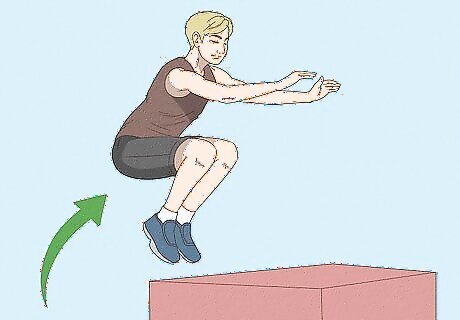
Utilize box jumps. Box jumps are a common exercise for utilizing plyometrics to increase your vertical leap. Doing box jumps increases your explosion and coordination by training your muscles to explode upward. As the name states, box jumps are simply jumping up onto a box from a stationary standing position using a single step approach. Many fitness facilities have specialized boxes specifically built for this exercise. Keep doing box jump repetitions for about 10 jumps x 3 sets, 2-3 times a week for the best results. Ensure there is enough room for you to jump without hitting your head on anything. Ensure that the box is stable and does not slip out from under you as you land on top of it. Slowly increase the height of the box as your vertical begins to increase.
Emphasizing Technique

Time your steps. Whether you’re attacking for a spike or defending with a block, the correct footwork will maximize the height of your jump. Your footwork will depend on your dominant hand. If you are going up to spike the ball, plant your second foot facing sideways and take off facing parallel to the net. Making your last two steps fast and explosive will significantly help your vertical leap. Use 3 steps to explode into your jump to improve your accuracy. For right-handed players, use a left, right, left, jump technique. Your spike approach should include one big step and one small step to bring your trailing foot in line with your leading one.

Coordinate both arms with your footwork to generate force. The height you get on each jump partly comes from the timing of your arms. Accelerate your arm swing as you bring your second foot forward - remember, you're not swinging forward, you're swinging up. The combination of planting your second foot a little bit in front of your first and then swinging your arms upwards will stop your forward momentum and transfer it to upwards momentum. A quick, aggressive approach with your arms swinging completely back and up will drive your body into the air. Move your arms in the direction that you want to go. Force your arms downward as you squat to initiate your base. As you explode into your jump, reverse the direction of your arms and push them above your head as fast as you can. As you reach the apex of your jump, your hands and body will have uncoiled into the highest point of your jump. If you are following the left, right, left, jump technique, throw your hands back and turn your palms to the ceiling on the right step. While you are in the air, come through with your non-dominant hand. The hand you're hitting with will usually be the dominant hand. As you advance in the sport, adjust your footwork and coordination for different attacking and defending positioning.

Engage your core. Turning your body to hit the ball will allow you to engage your core when you spike creating greater force upon impact. By using your whole body this way, you will be able to hit harder than you ever would with just your arm. Flex your core as if it were a bow about to release an arrow with your back and abdominal muscles working in unison. Working on the technique of your approach and arm swing is very important to maximizing the movements of your core.















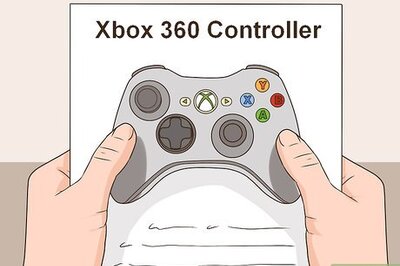



Comments
0 comment